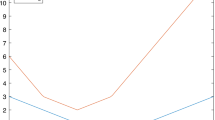Abstract
Convex relaxation methods are commonly used to solve nonconvex mathematical optimization problems. These methods transform the original nonconvex problem in such a way that effective methods of solving convex optimization problems become applicable. Thus, a convex problem giving the approximate solution of the original task can be solved instead of the original computationally complex problem. Presented is the application of semidefinite relaxation to the task of determining the optimal set of Global navigation satellite systems signals that are selected for processing while solving the positioning problem. The need for signals set optimization is due to large number of navigation satellites accessible for the customers on the ground level. This binary optimization problem is hard to solve in real time. Two approaches are proposed to reduce the initial problem to the convex problem allowing the effective solution.





Similar content being viewed by others
References
Yarlagadda, R., Ali, I., Al-Dhahir, N. & Hershey, J. GPS GDOP Metric. IEE Proc.: Radar, Sonar Navigation 147(no. 5), 259–263 (2000).
Teng, Y. & Wang, J. New Characteristics of Geometric Dilution of Precision (GDOP) for Multi-GNSS Constellations. J. Navigation 67(no. 6), 1018–1028 (2014).
Teng, Y. & Wang, J. A Closed-Form Formula to Calculate Geometric Dilution of Precision (GDOP) for Multi-GNSS Constellations. GPS Solutions 20(no. 3), 331–339 (2016).
Meng, F., Wang, S. & Zhu, B. Research of Fast Satellite Selection Algorithm for Multi-Constellation. Chinese J. Electronics 25(no. 6), 1172–1178 (2016).
Meng, F., Zhu, B., and Wang, S.A New Fast Satellite Selection Algorithm for BDS-GPS Receivers, IEEE Workshop on Signal Processing Systems, SiPS: Design and Implementation, 2013, pp. 371–376.
Kong, J.H., Mao, X., and Li, S.BDS/GPS Satellite Selection Algorithm based on Polyhedron Volumetric Method, IEEE/SICE Int. Symp. on System Integration (SII’2014), 2014, pp. 340–345.
Swaszek, P.F, Hartnett, R.J., Seals, K.C., and Swaszek, R.M.A.A Temporal Algorithm for satellite Subset Selection in Multi-Constellation GNSS, Proc. of the 2017 Int. Technical Meeting of The Institute of Navigation (ITM 2017), 2017, pp. 1147–1159.
Wei, J., Ding, A. & Li, K. et al. The Satellite Selection Algorithm of GNSS based on Neural Network, in Lecture Notes in. Electrical Engineering 388, 115–123 (2016).
Liu, M., Fortin, M.A., Landry, Jr.R., A Recursive Quasi-Optimal Fast Satellite Selection Method for GNSS Receivers, 22nd Int. Technical Meeting of the Satellite Division of the Institute of Navigation 2009 (ION GNSS 2009), 2009, vol. 5, pp. 3022–3032.
Ma, Z., Yang, L. & Jia, X. et al. Optimal Satellite Selecting Algorithm in GPS/BDS Navigation System and Its Implementation, in. Lecture Notes in Electrical Engineering 340, 117–127 (2015).
Polyak, B. T. & Shcherbakov, P. S. Robastnaya ustoichivost’ i upravlenie (Robust Stability and Control). (Nauka, Moscow, 2002).
Boyd, S. & Vandenberghe, L. Convex Optimization. (Cambridge Univ. Press, Cambridge, 2004).
Lobo, M. S., Vandenberghe, L., Boyd, S. & Lebret, H. Applications of Second-Order Cone Programming. Linear Algebra Its Appl. 284(no. 1-3), 193–228 (1998).
Rapoport, L. and Tormagov, T.Using of the SDP Relaxation Method for Optimization of the Satellites Set Chosen for Positioning, Proc. of the 31st Int. Technical Meeting of the Satellite Division of the Institute of Navigation (ION GNSS + 2018), 2018, pp. 3812–3820.
Rapoport, L.Usage of SDP Relaxation in Some GNSS Navigation Problems, DEStech Trans. Computer Sci. Eng., 2018 IX Int. Conf. on Optimization and Applications (Optima 2018), Petrovac: DESTech Publications, 2018, Suppl. Vol., pp. 325–335.
Domahidi, A., Chu, E., and Boyd, S.ECOS: An SOCP Solver for Embedded Systems, 2013 Eur. Control Conf. (ECC 2013), 2013, pp. 3071–3076.
O’Donoghue, B., Chu, E., Parikh, N. & Boyd, S. Conic Optimization via Operator Splitting and Homogeneous Self-Dual Embedding. J. Optimiz. Theory and Appl. 169(no. 3), 1042–1068 (2016).
Fujisawa, K., Nakata, K., Yamashita, M. & Fukuda, M. SDPA Project: Solving Large-Scale Semidefinite Programs. J. Operat. Res. Soc. Japan 50(no. 4), 278–298 (2007).
Borchers, B., & CSDP, A C Library for Semidefinite Programming. Optimiz. Methods Software 11(no. 1), 613–623 (1999).
Author information
Authors and Affiliations
Rights and permissions
About this article
Cite this article
Rapoport, L., Tormagov, T. Relaxation Methods for Navigation Satellites Set Optimization. Autom Remote Control 81, 1711–1721 (2020). https://doi.org/10.1134/S0005117920090106
Received:
Revised:
Accepted:
Published:
Issue Date:
DOI: https://doi.org/10.1134/S0005117920090106




